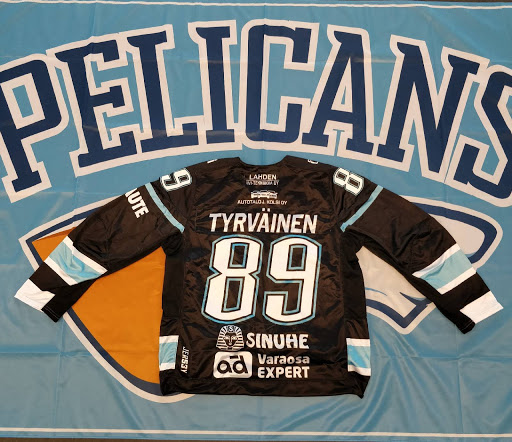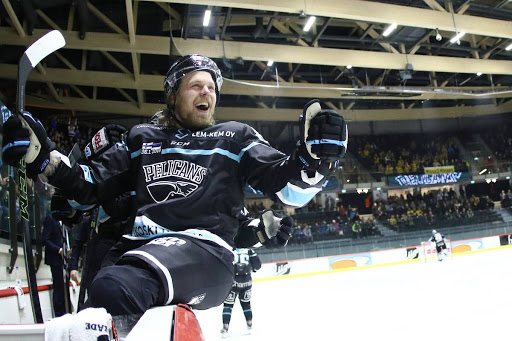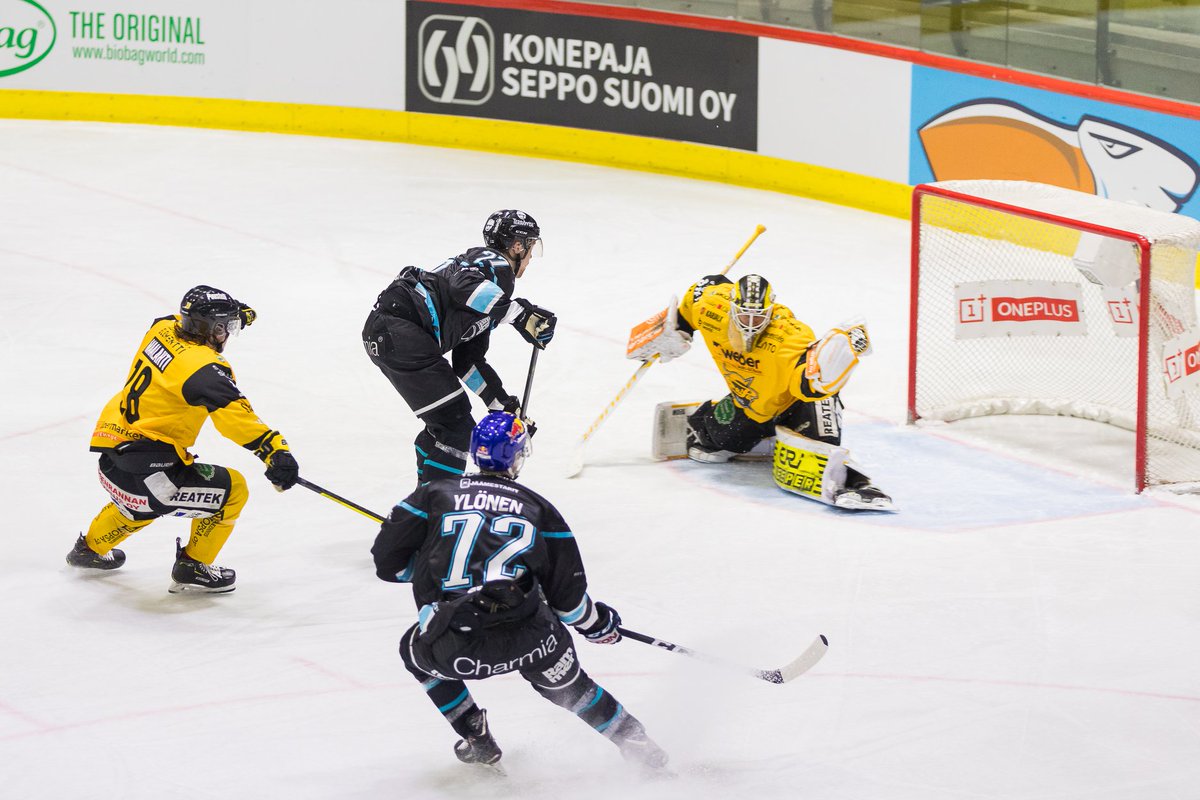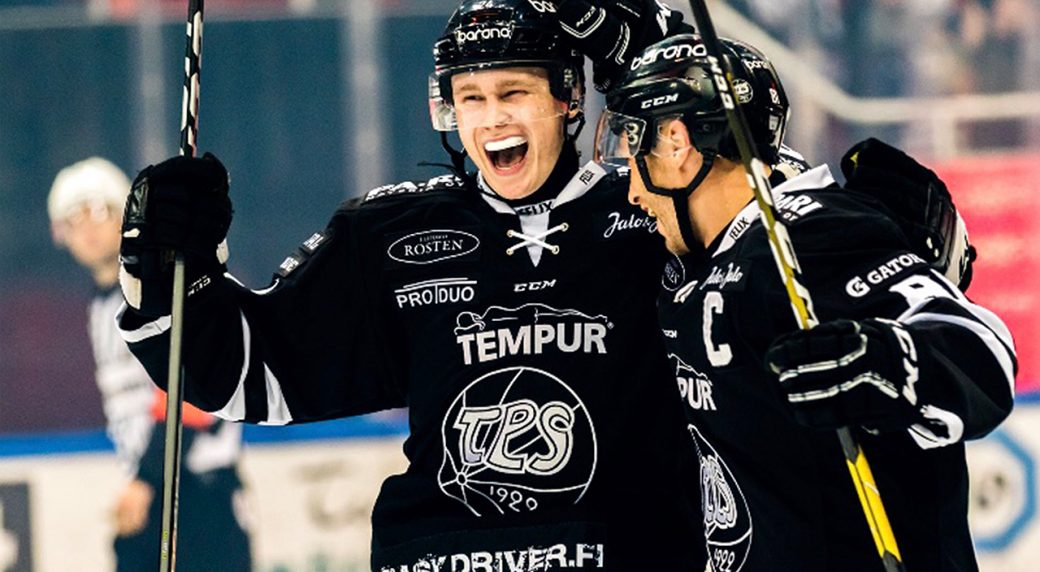
A lot has changed in Lahti since I last watched the Pelicans in action against Assat in late February 2018. As you come to expect a lot of players leave and are replaced but perhaps the biggest loss was always going to be that of leading scorer, Iikka Kangasniemi who had been rumoured to be leaving Lahti over the previous couple of seasons.
He eventually did leave over the summer, signing for HIFK, but if there were concerns his golden helmet couldn’t be filled, think again. Czech winger Hynek Zohorna who arrived from HC Kometo Brno in his homeland has more than replaced the diminutive Kangasniemi this season, scoring goals for fun. Not least with his heroics in Tallinna, but more of that later.
Other notable forwards to depart were Aleksi Rekonen who signed with Assat Pori, Kimi Koivisto (KooKoo) and Fourth line Left Wing Joonas Alanne who is now icing in the Asia League, while Russian Right Wing Vadim Pereskokov opted to return to the KHL mid-season, last year.
With gaps on the roster it forced new coach Ville Nieminen into changing the line up slightly. Aleksi Mustonen now centers the top line with Zohorna and Jesse Saarinen, while local favourite Hannes Bjorninen now finds himself between Jesse Mankinen and youngster Severi Lahtinen.
Experienced pair Antti Tyrvainen and Miska Siikonen are tasked with helping Arizona-born youngster Jesse Ylonen to hone his skills in Finland. That, however, may not be required, with the Youngster making headlines all on his own.
Ylonen scored a great goal in the World Junior Finals recently for Finland against the country of his birth helping his side to claim the Gold Medal and has looked impressive throughout the campaign for the Pelicans too. Ylonen’s dad Juha was an NHL veteran, spending time with the Phoenix Coyotes and Ottawa Senators and there is absolutely no reason why Jesse can’t repeat those accomplishments, judging on his performances so far.
The fourth line does have a familiar look to it though, with Taavi Vartiainen and Roope Elimaki still with the team. However, with Alanne having left that has opened up spaces for the likes of youngster Artturi Toivola and new signing Mikko Laine.
Roope Makitalo, Niklas Salo, Sakke Hamaleinen and Walter Merela are all new forwards for this season too.
You could say subtle changes have taken place amongst the forward units, but wholesale ones have taken place on the blue line, with a much more youthful look to it.
Of the many blueliners to depart, Dane Stefan Lassen moved to the Swedish Second tier, Allsvenskan, while the Czech, Libor Sulak got a crack at plying his trade in the AHL. Alex Lindroos is now with JYP, while Juha Leimu, who holds the Record for the ‘Fastest Hat Trick in Liiga’ signed with Ilves and Roni Rukajarvi dropped down to play in the Swedish First Division. Jordan Rowley initially opted to play in the EBEL, but he has since returned to Lahti just this week although not soon enough to take part in Tallinna.
That has meant a very different looking set of defensive pairings to the ones I saw last season. 19-year-old newcomer, Santtu Kinnunen is often partnered with the more experienced Mikko Kousa on the top pairing. Kousa has been with the Pelicans a while now so is considered the leader on the blue line, (mainly because he is a rarity in that he has been with the team longer than the past two seasons). Jarkko Pynnonen and Oliwer Kaski are not much older than Kinnunen and are only in their early twenties themselves, but despite this being their first season with the Pelicans have formed a good partnership on the second pairing. Aleksi Ek who only has one season of senior hockey under his belt is another young defenseman and he teams up with the more experienced Swede Henrik Nilsson, himself a new signing this summer. While, Aapo Ahola (19) is usually the seventh defensemen. Missing on defense from the game in Tallinna was 21-year-old Russian Alexander Shchemerov who hails from Yekaterinburg and at 25 the veteran Mikhail Teppo.
Both goalies have both changed since last year too. Janne Juvonen now plays in the Swedish Hockey League, while the youngster Joona Voutilainen looks to fulfil his promise with JYP now. In their place has arrived Juho Olkinuora (coming the other way from JYP) who is the new starting goalie and Czech back-up, Jakub Skarek.
As mentioned above the Pelicans are now coached by Ville Nieminen, replacing Petri Matikainen who had been behind the Pelicans bench the previous three seasons. Nieminen though is someone who is a big name in hockey. During his playing career he spent several seasons in the NHL, most notably with some of my favourite sides, Pittsburgh, Chicago, San Jose and St Louis.
Born in Tampere, Nieminen started his NHL career with the Colorado Avalanche, back when they were a powerhouse in the game, but his most successful stint was with the Calgary Flames as he helped the side reach the 2004 Stanley Cup Finals, playing in every post season game during that campaign.
The previous two seasons have seen Nieminen coach Jukurit, helping the Mikkeli-based side to establish themselves in the top flight since earning promotion to Liiga in 2016.
With the new look side assembled and myself becoming more familiar with them, it was time to take in a game this season.
The annual trip to Tallinna has quickly became the highlight of the season for the Pelican’s fans and edition two of this initial three-year deal didn’t disappoint. The Pelicans were looking to put last season’s defeat to local rivals HPK behind them, but they had to come from behind to do so.

A crowd of 4,860 spectators were in attendance at Tallinn’s Tondiraba Arena to see Pelicans Lahti take on SaiPa Lappeenranta, in what was only the second such occasion a Liiga game had been played in Estonia.
The two sides had met just 24 hours earlier in Lappeenranta, with Pelicans surrendering a two-goal lead to eventually lose 3-2. With that in mind some thought this might be a tense and tight affair but instead it was a game played to the level of a playoff contest such was the intensity.
SaiPa looked like getting the early breakthrough when one of their players was left completely unmarked in front of goal following a pass through the middle, but the shot was lifted a bit too high over Pelicans goalie Jussi Olkinuora and hit the bar.
Pelicans seemed unable to get their usual flowing game going and it should have come to nobody’s surprise when SaiPa scored.
With Hynek Zohorna serving a penalty for tripping, SaiPa used the opportunity to take an early lead. Kalle Maalahti passed the puck out to Ahti Oksanen on the Right Wing from the point, Oksanen then sent the puck towards the crease where Jon Nikko stabbed away at it before it became loose at the back post for Cody Kunyk to scramble home at 8:15 of the first period.
Santeri Virtanen Could have made it two for SaiPa, after some great puck possession saw him escape the clutches of Severi Lahtinen to put a shot on net.
Eventually, Pelicans did respond after giving up that goal, but Frans Tuohimaa in the SaiPa net stood in their way, stopping one good effort from a hard shot, and commanding his crease well overall.
Early in the second period Pelicans were back on level terms. A fast break out of their own zone saw Jesse Saarinen play it out wide to Zohorna on the Right Wing. Zohorna then cut inside before sending a back handed pass out to the left for the on-rushing Santtu Kinnunen to one-time a shot in a sweet sweeping motion, beating Frans Tuohimaa on the near side in the SaiPa goal.
The major talking point of the game came at 28:42 when Vladimir Denisov received a 5 plus game penalty for kneeing Miska Siikonen. However, despite the Pelicans having a five-minute powerplay they were unable to take advantage and break the deadlock. Their best opportunity came with a lovely flowing move which saw the Pelicans break out the zone fast once again with slick one-time passing between, Antti Tyrvainen, Jesse Ylonen and Siikonen, but the latter’s shot could only find Tuohimaa’s glove. Thankfully Siikonen showed no lasting effects of that nasty clash to play a part in his sides best chance with the man advantage.
Pelicans took their first lead of the game at 47:25 when Santtu Kinnunen banked a pass of the boards to find Jesse Saarinen out on the left wing. Saarinen then cut inside towards goal and went around Markus Kojo as if he wasn’t there before deceiving Jere Sneck by going forehand to backhand and then back to forehand again before unleashing a shot which beat Tuohimaa on his near side over the shoulder for a beautiful goal.
However, the celebrations had barely began when straight from the resulting face-off Joni Nikko forced a turn over at center ice and slipped a pass through to Tyler Morley. SaiPa’s leading scorer drilled a low shot from the left which found its way into the bottom corner of Pelican’s net to square things up again. The two goals arriving just nine seconds apart. Indeed, the usual ‘Pelicans on Ykkonen’ chant which follows every goal, didn’t even have time to start until well after SaiPa had equalised.
There was a lengthy delay when Aapo Ahola got put through the plexi-glass, shoulder first, by Cody Kunyk which meant we had to wait for the panel to be replaced. The players were ordered off the ice and back to their dressing rooms while the work could be carried out and then the Zamboni had to resurface that area to ensure no glass remained on the ice.
With no further goals in regulation, we headed to 3-on-3 overtime where the Pelicans looked determined to settle the contest there and then. The ‘home’ side looked much the better team during the extra session and really took the game to SaiPa. The team from Lappeenranta appeared to be hanging on for dear life at this stage and almost looked relieved when the buzzer sounded, to signal penalty shots.
Jesse Ylonen was first to go for Pelicans, but he was unable to find a way past Frans Tuohimaa in the SaiPa net. Ahti Oksanen, who was SaiPa’s first shooter, didn’t have the same problem though as he slotted his effort past Juho Olkinuora.
Oliwer Kaski and Elmeri Kaksonen both missed their efforts for their respective sides, meaning it was all on Hynek Zohorna. Miss and it would be a second straight loss on Estonian ice for the Pelicans, score and it would place the pressure firmly on SaiPa’s next shooter.
The man with the golden helmet had no trouble as he fired passed Tuohimaa to the delight of the screaming Pelicans fans behind the goal. Still though if SaiPa scored their third and final shot then they would still win the game. However, Joni Nikko was unable to beat Okinuora meaning we would head into sudden death.
After each side has taken three shots the penalty takers change order, so where Pelicans had gone first for the opening three attempts, now SaiPa would have to shoot first. This would happen after every three rounds so could alternate as many times as it takes to find a winner. It also meant that now a team could have any player take a shot. The first three attempts all must be different players but from the fourth round of shots onwards, you can name the same player to take every shot if you so wish. SaiPa opted to go with their successful penalty scorer from round 1, Ahti Oksanen, but he couldn’t repeat his effort from earlier, firing his shot wide of Okinuora’s right post meaning Pelicans now had a chance to win it.
Like SaiPa, Pelicans opted to go with their sole successful scorer, meaning Zohorna was going to be shooting again. The Czech repeated his effort, with the same outcome, drifting right before toying with Tuohimaa, like a cat playing with a mouse, waiting for him to make the first move. The Czech sniper then deked to the right before taking the puck around the left of the goalie and cutting onto his backhand to slip the winning goal home (Scoring with two identical backhand shots) and spark jubilation in the Pelicans Fan section behind the goal. The post-game celebrations lasted for over 20 minutes as the fans and players united as one in the team’s success.

Having lost in a shoot-out last year, some of the wrongs against HPK were corrected this time against SaiPa meaning the fans who had travelled from Lahti (and two from Newcastle) could celebrate long into the night.
It’s moments like these that remind you just how great the game of hockey is, two Finnish teams playing a Liiga game in Estonia with over 4,000 fans travelling from Lahti to witness their side win. But the occasion is much bigger than the points collected and for those travelling fans it means everything.
I have said it many times before but for me Finland has the best sports fans in the world. I have been fortunate enough to witness Finns support Mika Hakkinen and Kimi Raikkonen at Formula 1 events and been impressed with the fun they have whilst doing so. It is the same with hockey. I have watched hockey all over the world but no where can match the passion and fan culture that the Finns have. And although I am perhaps a little biased, the Pelicans have the best fans in Finland.
I first visited Finland a couple of years ago to watch five games of hockey. I assumed being based in Helsinki would be a smart move and make it easy to watch teams from the capital or places that are an easy enough commute from there (Tampere, Lahti etc.). Game two of the trip took place in Lahti and having witnessed my first game there I instantly fell in love with the team. My final game of the trip was supposed to take place in Espoo to watch a contest in the Mestis League but having realised Pelicans would be playing KooKoo in Kouvola I quickly changed my plans and headed there instead. It was one of the smartest moves I would ever make as I made some great friends that day, who make trips like this so memorable.
This year my friend Keith came on the trip and he remarked at how great the Pelicans fans were before, during and after the game and how it’s like nothing we are used to experiencing in England. That’s the thing with watching Pelicans games, once you have seen one you are hooked for life, and they now have two fans from across the North Sea cheering them on. We now just can’t wait for Tallinna Part 3 next year!
Game Highlights: https://liiga.fi/fi/ottelut/2018-2019/runkosarja/384/kooste/
Line Ups



/arc-anglerfish-tgam-prod-tgam.s3.amazonaws.com/public/2URWKUAD4FC6BC4AA6IOGWKXZY.jpg)
/cdn.vox-cdn.com/uploads/chorus_image/image/62791479/1087622858.jpg.0.jpg)

